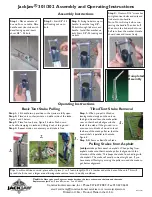
In temperate climates, the maximum period of time the watermaker should be stored without
preserving the membrane is approximately one week. In hot or tropical climates, the
watermaker membrane should be preserved if it will not be used within the next three days.
Follow these directions to preserve the membrane of your watermaker:
1.
Turn the Clean/Run Valve lever on the pump to its “Clean” position (see
Figure 8
).
2.
Fill a clean plastic container or bucket with two quarts (approximately 2 liters) of clean
water. Freshwater is preferable, but clean seawater may be used if freshwater is not
available.
(
Caution:
Never
use chlorinated freshwater. This may damage the
membrane.)
3.
Mix two spoonfuls (approximately 20 grams, or 1% by weight) of dry
Membrane
Preservative
chemical with the water in the container and stir until completely dissolved.
4.
Use your product 3-way valve (or move the product water output hose) to be sure that
any water flowing from the product freshwater output is properly discarded.
5.
Turn the lever on the prefilter 3-way valve to the alternate intake position. Run the 1/4"
alternate intake hose with the strainer attached into the container of membrane
preservative solution.
6.
Turn on the watermaker and run it until almost all of the membrane preservative has
been drawn from the container and foamy membrane preservative solution is ejecting
from the reject brine hose. If there is a chance that the watermaker will be subjected to
freezing conditions, continue to run until air is being ejected from the reject brine hose.
(
Note:
If the membranes freeze, they must be slowly and completely thawed before the
watermaker may be used again.)
7.
Turn off the watermaker. It is now ready for storage for up to one year.
If seawater was used instead of freshwater, repeat the membrane preserving procedure with
freshwater as soon as possible. Repeat the above procedure at least once a year if the
watermaker is not being operated.
Cleaning the Membrane:
We do not recommend casual or regular cleaning of the
reverse osmosis membranes in the watermaker—it should only be done when needed. Under
normal use conditions, when only open-ocean seawater is being processed, cleaning the
membranes should rarely (or never) be necessary. Proper membrane
preservative treatments prior to extended periods of non-use will
reduce biological growth on the membrane surface. Under these
conditions and with proper care, a membrane can be used for years
without requiring a cleaning.
Cleaning the membranes is only necessary if contaminants are
deposited on, and adhere to, the membrane surface in sufficient
amounts to affect the output of product freshwater. Usually this
condition also causes battery current to increase. There are two main
types of such deposits and a different chemical cleaner is needed for
each type:
•
Organic Growth
—usually caused by processing
brackish water or failure to properly store a membrane during extended periods of
non-use. Use
Alkaline Cleaner
.
Note:
Buildup of
deposits and reduction
in product freshwater
flow usually take place
gradually over
extended periods of
time. Sudden reduction
or stopping of product
water output is rarely
caused by a dirty
membrane.
•
Mineral Scale
—caused by mineral impurities in the intake water supply. Use
Acid
Cleaner
.
13
Содержание PowerSurvivor 80E
Страница 1: ...PowerSurvivorTM 80E Endurance Series 12 Volt 24 Volt Watermakers OWNER S MANUAL...
Страница 2: ...II...
Страница 27: ...Diagrams 23...
Страница 28: ...24...
Страница 29: ...25 25...
Страница 30: ...26...
Страница 33: ...Service Log Date Preserved M b Cleaned M b Other Service 29...
Страница 34: ...30...
















































